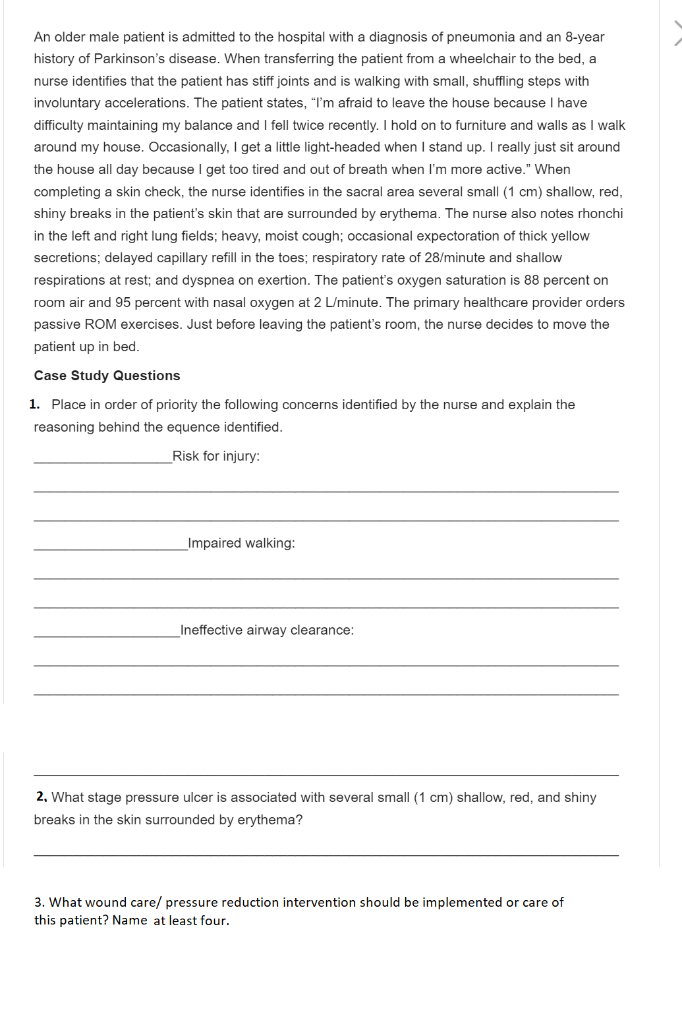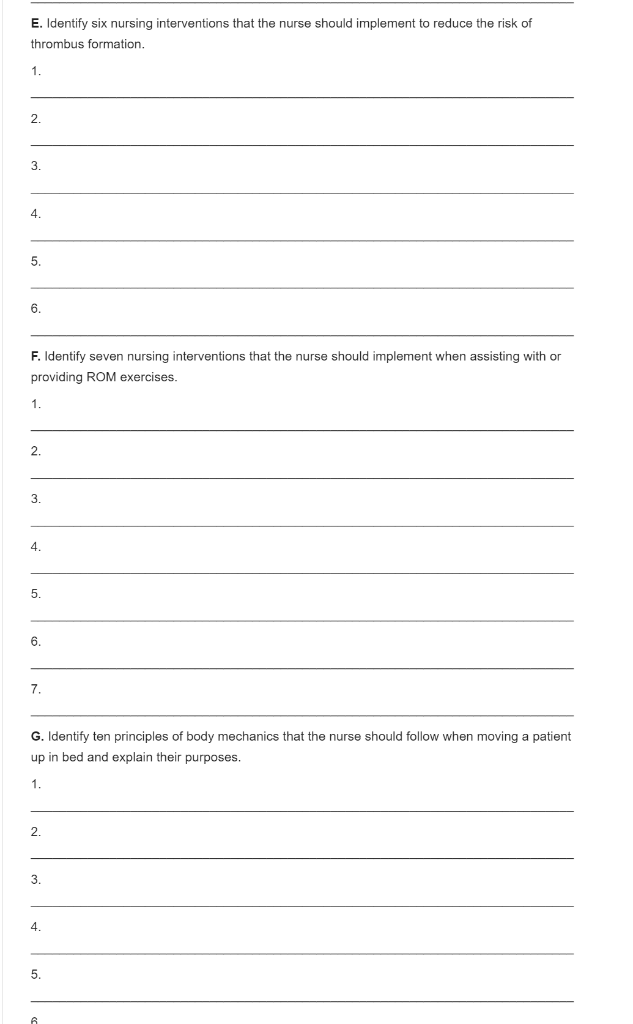Anatomy & Physiology
1st Edition
ISBN:9781938168130
Author:Kelly A. Young, James A. Wise, Peter DeSaix, Dean H. Kruse, Brandon Poe, Eddie Johnson, Jody E. Johnson, Oksana Korol, J. Gordon Betts, Mark Womble
Publisher:Kelly A. Young, James A. Wise, Peter DeSaix, Dean H. Kruse, Brandon Poe, Eddie Johnson, Jody E. Johnson, Oksana Korol, J. Gordon Betts, Mark Womble
Chapter16: The Neurological Exam
Section: Chapter Questions
Problem 1ILQ: Watch this video (http://openstaxcollege.org/l/neuroexam) that provides a demonstration of the...
Related questions
Question

Transcribed Image Text:An older male patient is admitted to the hospital with a diagnosis of pneumonia and an 8-year
history of Parkinson's disease. When transferring the patient from a wheelchair to the bed, a
nurse identifies that the patient has stiff joints and is walking with small, shuffling steps with
involuntary accelerations. The patient states, "I'm afraid to leave the house because I have
difficulty maintaining my balance and I fell twice recently. I hold on to furniture and walls as I walk
around my house. Occasionally, I get a little light-headed when I stand up. really just sit around
the house all day because l get too tired and out of breath when I'm more active." When
completing a skin check, the nurse identifies in the sacral area several small (1 cm) shallow, red,
shiny breaks in the patient's skin that are surrounded by erythema. The nurse also notes rhonchi
in the left and right lung fields; heavy, moist cough; occasional expectoration of thick yellow
secretions; delayed capillary refill in the toes; respiratory rate of 28/minute and shallow
respirations at rest; and dyspnea on exertion. The patient's oxygen saturation is 88 percent on
room air and 95 percent with nasal oxygen at 2 L/minute. The primary healthcare provider orders
passive ROM exercises. Just before leaving the patient's room, the nurse decides to move the
patient up in bed.
Case Study Questions
1. Place in order of priority the following concerns identified by the nurse and explain the
reasoning behind the equence identified.
Risk for injury:
Impaired walking:
Ineffective airway clearance:
2, What stage pressure ulcer is associated with several small (1 cm) shallow, red, and shiny
breaks in the skin surrounded by erythema?
3. What wound care/ pressure reduction intervention should be implemented or care of
this patient? Name at least four.

Transcribed Image Text:E. Identify six nursing interventions that the nurse should implement to reduce the risk of
thrombus formation,
1.
2.
3.
4.
5.
6.
F. Identify seven nursing interventions that the nurse should implement when assisting with or
providing ROM exercises.
1.
2.
3.
4.
5.
6.
7.
G. Identify ten principles of body mechanics that the nurse should follow when moving a patient
up in bed and explain their purposes.
1.
2.
3.
4.
5.
6.
Expert Solution
This question has been solved!
Explore an expertly crafted, step-by-step solution for a thorough understanding of key concepts.
This is a popular solution!
Trending now
This is a popular solution!
Step by step
Solved in 6 steps

Recommended textbooks for you

Anatomy & Physiology
Biology
ISBN:
9781938168130
Author:
Kelly A. Young, James A. Wise, Peter DeSaix, Dean H. Kruse, Brandon Poe, Eddie Johnson, Jody E. Johnson, Oksana Korol, J. Gordon Betts, Mark Womble
Publisher:
OpenStax College

Medical Terminology for Health Professions, Spira…
Health & Nutrition
ISBN:
9781305634350
Author:
Ann Ehrlich, Carol L. Schroeder, Laura Ehrlich, Katrina A. Schroeder
Publisher:
Cengage Learning

Anatomy & Physiology
Biology
ISBN:
9781938168130
Author:
Kelly A. Young, James A. Wise, Peter DeSaix, Dean H. Kruse, Brandon Poe, Eddie Johnson, Jody E. Johnson, Oksana Korol, J. Gordon Betts, Mark Womble
Publisher:
OpenStax College

Medical Terminology for Health Professions, Spira…
Health & Nutrition
ISBN:
9781305634350
Author:
Ann Ehrlich, Carol L. Schroeder, Laura Ehrlich, Katrina A. Schroeder
Publisher:
Cengage Learning